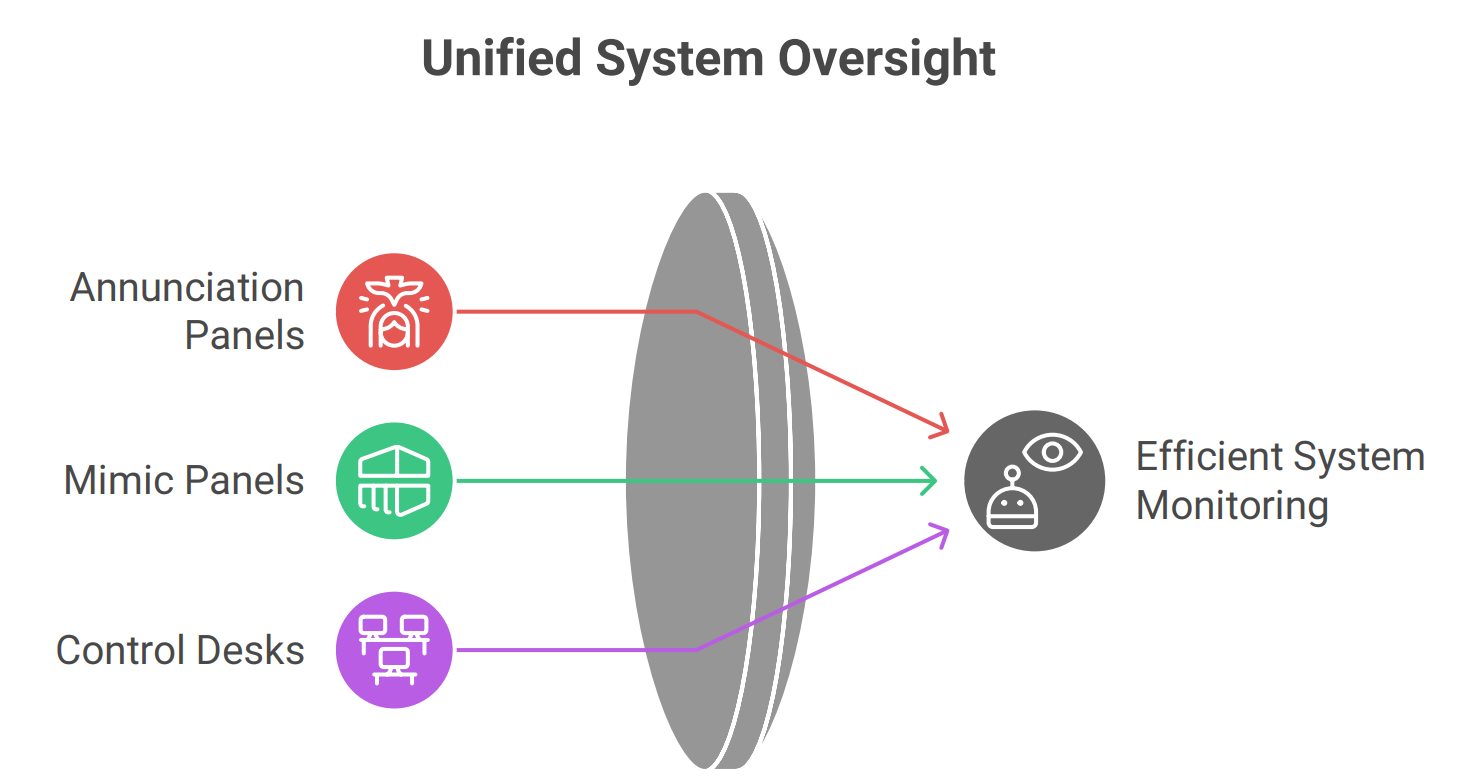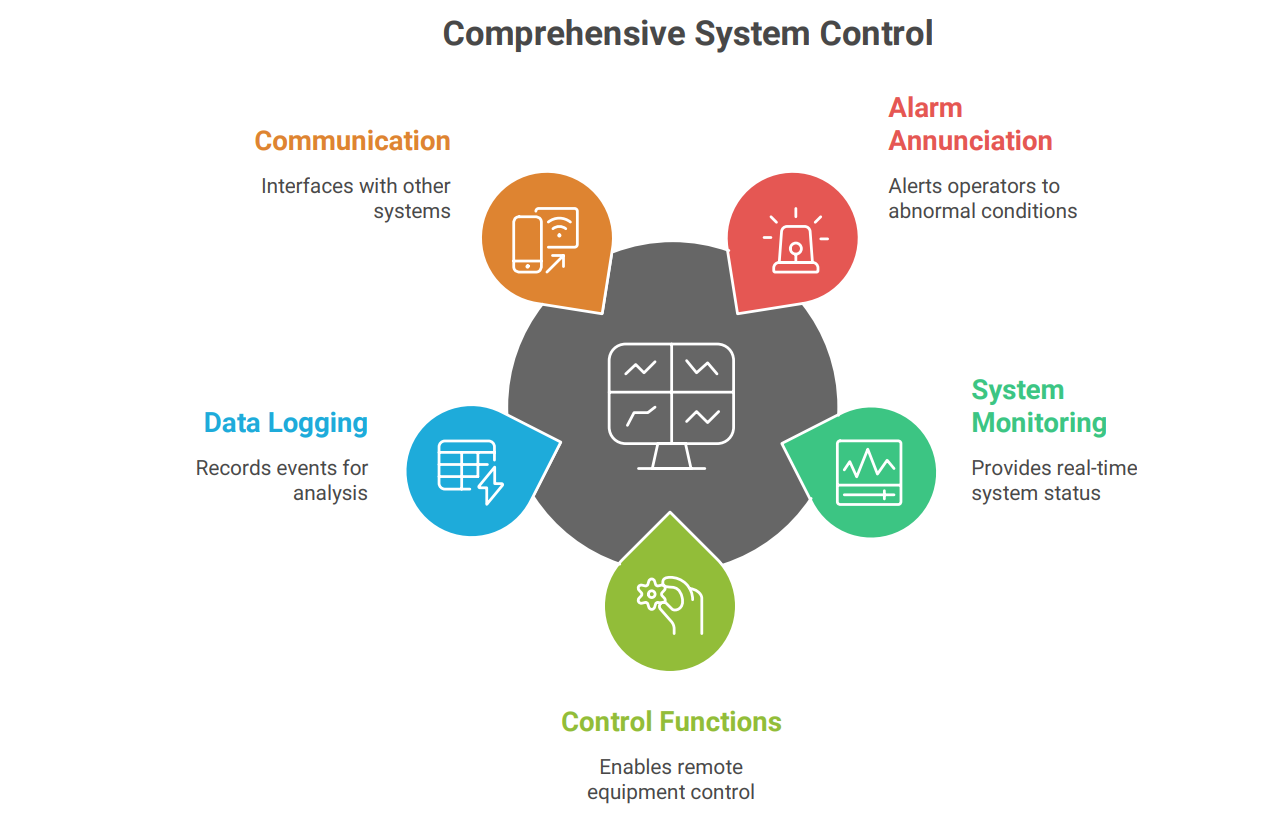Introduction to Annunciation Panels
Annunciation panels, mimic panels, and control desks are essential components in various industrial and commercial settings where continuous monitoring and control of complex systems are required. These panels provide a visual representation of the system, allowing operators to quickly identify the location and nature of alarms, equipment status, and other critical information.

Purpose and Functionality
The primary purpose of an annunciation panel is to alert operators to abnormal conditions or events within a system. This is achieved through visual and audible alarms that indicate the specific location and nature of the problem. In addition to alarm annunciation, these panels often provide control functions, allowing operators to remotely start or stop equipment, adjust setpoints, and perform other control actions.
Key functionalities include:
• Alarm Annunciation: Displaying visual and audible alarms to alert operators to abnormal conditions.
• System Monitoring: Providing a real-time overview of the system's status, including equipment operating conditions, process variables, and other relevant information.
• Control Functions: Enabling operators to remotely control equipment and adjust system parameters.
• Data Logging: Recording alarm events and system status changes for historical analysis and troubleshooting.
• Communication: Interfacing with other control systems and devices to exchange data and commands.

Types of Annunciation
Annunciation can be categorized based on the type of signal used to indicate an alarm or status change:
• Discrete Annunciation: Uses individual indicator lights or LEDs to represent specific alarm points or equipment status. Each point has a dedicated input and output.
• Multiplexed Annunciation: Employs a multiplexing technique to reduce the number of wiring connections required for a large number of alarm points. This involves scanning multiple inputs and displaying the corresponding alarm information on a shared display.
• Computer-Based Annunciation: Utilizes a computer or programmable logic controller (PLC) to process alarm signals and display information on a graphical user interface (GUI). This allows for more sophisticated alarm management and data logging capabilities
Panel Construction and Design
The construction and design of an annunciation panel are critical to its functionality and reliability. Key considerations include:
• Panel Material: Typically constructed from steel or aluminum, depending on the environmental conditions and required durability.
• Panel Layout: Designed to provide a clear and intuitive representation of the system being monitored. The layout should be logical and easy to understand, with alarm points and control devices clearly labeled.
• Indicator Lights: LEDs are commonly used for indicator lights due to their long lifespan, low power consumption, and bright illumination. Different colors can be used to indicate different alarm priorities or equipment status.
• Audible Alarms: Buzzers, horns, or synthesized voice alarms are used to provide audible alerts. The volume and tone of the alarm should be adjustable to suit the environment.
• Control Devices: Pushbuttons, switches, and potentiometers are used to provide control functions. These devices should be robust and reliable, with clear labeling and tactile feedback.
• Wiring and Termination: Proper wiring practices and termination techniques are essential to ensure reliable operation. Wiring should be neatly organized and labeled, with adequate strain relief and protection against damage.
• Power Supply: A reliable power supply is critical to the operation of the annunciation panel. The power supply should be sized to handle the load of all the indicator lights, alarms, and control devices.
Integration with Control Systems
Annunciation panels are often integrated with other control systems, such as distributed control systems (DCS) or programmable logic controllers (PLCs). This integration allows for seamless communication and data exchange between the annunciation panel and the control system.

Integration can be achieved through various methods, including:
• Hardwired Connections: Discrete signals are wired directly from the control system to the annunciation panel.
• Serial Communication: Data is transmitted between the control system and the annunciation panel using a serial communication protocol, such as Modbus or RS-485.
• Network Communication: Data is transmitted over a network, such as Ethernet, using a communication protocol such as TCP/IP or OPC.
Applications
Annunciation panels are used in a wide range of applications, including:
• Power Generation: Monitoring and controlling power plants, substations, and transmission lines.
• Oil and Gas: Monitoring and controlling oil and gas production, refining, and distribution facilities.
• Chemical Processing: Monitoring and controlling chemical plants and processes.
• Manufacturing: Monitoring and controlling manufacturing processes and equipment.
• Water and Wastewater Treatment: Monitoring and controlling water and wastewater treatment plants.
• Building Automation: Monitoring and controlling building systems, such as HVAC, lighting, and security.
• Transportation: Monitoring and controlling transportation systems, such as railways and airports.

Best Practices for Design and Implementation
• Clearly Define Requirements: Before designing an annunciation panel, it is essential to clearly define the requirements, including the number of alarm points, control functions, and communication interfaces.
• Use a Logical Layout: The panel layout should be logical and easy to understand, with alarm points and control devices clearly labeled.
• Choose Appropriate Components: Select high-quality components that are suitable for the environment and application.
• Implement Proper Wiring Practices: Use proper wiring practices and termination techniques to ensure reliable operation.
• Test and Commission Thoroughly: Thoroughly test and commission the annunciation panel before putting it into service.
• Provide Adequate Training: Provide adequate training to operators on the use of the annunciation panel.
• Maintain Regularly: Regularly maintain the annunciation panel to ensure its continued reliability.
Conclusion
Annunciation panels, mimic panels, and control desks are critical components in many industrial and commercial settings. By providing a clear and concise overview of the system's status and enabling operators to take appropriate actions, these panels help to improve safety, efficiency, and reliability. Proper design, implementation, and maintenance are essential to ensure the effective operation of annunciation panels.
